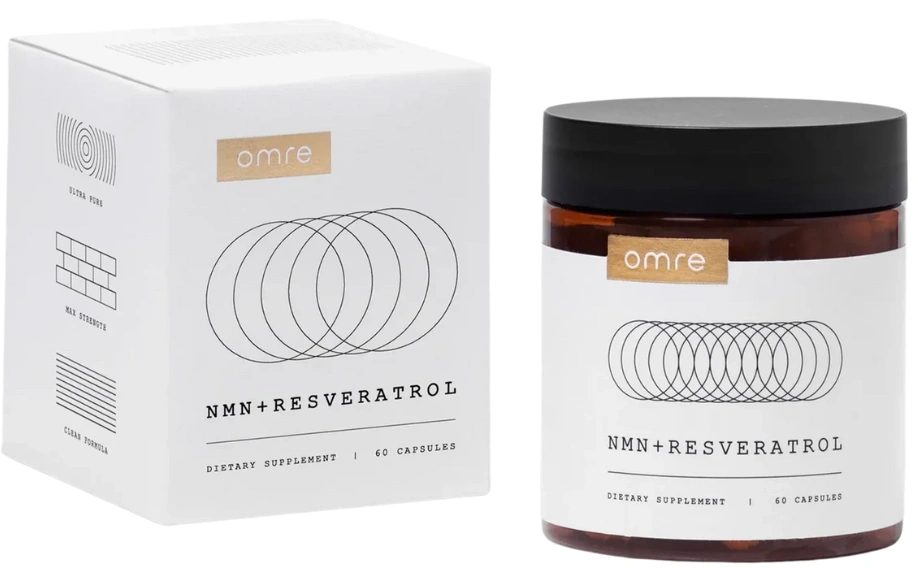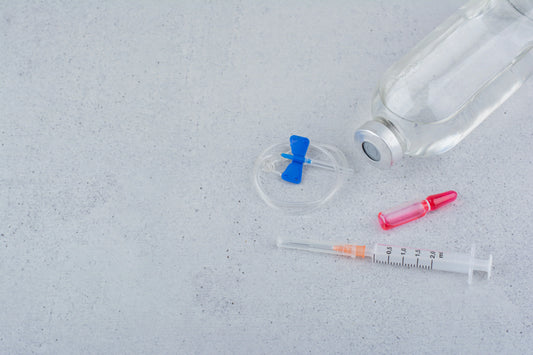Table of Contents
- TL;DR
- NAD IV vs Injection: Key Differences
- What is NAD+?
- What is NAD IV Therapy?
- Pros and Cons of NAD IV Therapy
- What is NAD Injection?
- Pros and Cons of NAD Injection
- NAD IV vs Injection: Which One Is Right for You?
- Are There Any Side Effects?
- Do These Treatments Actually Work?
- A Better Alternative to NAD IV and NAD Injections
- Final Words
- FAQs
NAD IV delivers a higher dose over a longer time, while NAD injections are quicker and more convenient. IV therapy may offer longer-lasting effects, but injections work well for short-term energy and maintenance. The better option depends on your health goals, time, and budget.
Both methods deliver NAD+, a molecule your body needs for energy and cellular repair. But they do it in different ways, and each comes with its own benefits and downsides.
If you're wondering whether a slow IV drip or a quick NAD shot is right for you, this breakdown will help you decide.
Cellular NAD+ booster with ultra‑pure NMN and Resveratrol, at research‑backed doses.*NMN + RESVERATROL
TL;DR
NAD IV therapy delivers a higher dose of NAD+ through a slow drip, which can lead to longer-lasting effects but requires more time and money. NAD injections, on the other hand, are faster, more affordable, and better suited for quick energy boosts or maintenance.
Choose NAD IV if you need sustained support, are managing fatigue or chronic issues, and don’t mind longer sessions.
Choose NAD injections if you want convenience, lower cost, and shorter treatment time.
Both have mild side effects and can help raise NAD+ levels, but which one is better depends on your goals, budget, and schedule.
NAD IV vs Injection: Key Differences
While both NAD IV and NAD injections aim to raise your NAD+ levels, they differ in how they’re delivered, how long they take, and how your body may respond.
What is NAD+?
NAD+ (nicotinamide adenine dinucleotide) is a molecule found in every cell that helps convert food into energy. It plays a key role in cellular repair, brain function, and metabolism. Without enough NAD+, your body struggles to maintain energy, especially as you age.
NAD+ also helps regulate important processes like DNA repair, inflammation, and sleep-wake cycles. It’s central to mitochondrial health, which affects how efficiently your body produces energy.
Unfortunately, NAD+ levels naturally drop with age. By the time you're in your 40s or 50s, your levels could be half of what they were in your 20s.
This drop has been linked to fatigue, slower metabolism, and cognitive decline.
Why Do People Supplement It?
People use NAD+ therapy or supplements to help restore levels and support healthy aging. Some also use it for more targeted reasons, including:
Fatigue and low energy: NAD+ supports ATP production, which fuels your cells. Low levels can leave you feeling drained (1).
Brain fog and focus: It helps maintain brain function and protect neurons, making it a popular choice for people struggling with memory or focus (2).
Addiction recovery and detox: Some IV clinics use NAD+ to help support withdrawal symptoms during detox from alcohol or opioids.
Chronic illness and inflammation: NAD+ plays a role in controlling oxidative stress, which can contribute to inflammation and disease.
Healthy aging and longevity: Studies suggest NAD+ may help slow age-related decline by supporting DNA repair and cellular health (3).
What is NAD IV Therapy?
-v1749415179955.webp) NAD IV therapy is a treatment where NAD+ is delivered directly into the bloodstream through a slow-drip IV infusion. This allows for larger doses over a longer period, often lasting 1.5 to 4 hours.
NAD IV therapy is a treatment where NAD+ is delivered directly into the bloodstream through a slow-drip IV infusion. This allows for larger doses over a longer period, often lasting 1.5 to 4 hours.
Clinics typically offer NAD IV as part of an anti-aging, energy, or detox program. The idea is that NAD+ bypasses the digestive system and goes straight into circulation, allowing for better absorption.
During the session, NAD+ is usually combined with fluids, electrolytes, and sometimes vitamins like B12 or magnesium. Patients may relax in a chair while the drip runs slowly to reduce side effects like flushing or cramping.
Some providers claim that NAD IV helps with energy, brain clarity, muscle recovery, and mood.
However, studies have raised questions about how well NAD+ from IVs actually gets into cells, given its large molecular size (4).
Pros and Cons of NAD IV Therapy
NAD IV therapy offers high-dose delivery and longer-lasting effects but takes more time and may cost more.
Pros of NAD IV Therapy
Higher dosage potential: NAD IV therapy can deliver 250 mg to 1000 mg in a single session.
Longer-lasting effects: Slow infusion may support more sustained energy and mood benefits for some users.
Hydration support: Often paired with fluids, which can help if you're dehydrated or recovering from illness.
Customization: Many clinics offer add-ons like glutathione or vitamin C.
Cons of NAD IV Therapy
Time-consuming: Sessions typically last 1.5 to 4 hours.
Expensive: Prices range from $250 to $1,000 or more per session.
Potential side effects: Some users experience nausea, chest tightness, or flushing during the drip.
Limited absorption evidence: Research suggests NAD+ may not enter cells easily through IV, reducing its effectiveness.
What is NAD Injection?
-v1749415217530.webp) NAD injections are intramuscular or subcutaneous shots that deliver a smaller dose of NAD+ quickly. These are often given in the glute or shoulder area and take just a few minutes.
NAD injections are intramuscular or subcutaneous shots that deliver a smaller dose of NAD+ quickly. These are often given in the glute or shoulder area and take just a few minutes.
NAD shots are usually administered in clinics or at home (if self-administered). Because they’re faster, they’re popular with people who want a quick energy or focus boost without the time commitment of IV therapy.
While the dose is smaller, usually between 50 mg and 100 mg, some people use them several times a week to maintain consistent NAD+ support. They're often seen as a more budget-friendly option.
Injections may also cause less discomfort overall, especially when done subcutaneously. Some providers note quicker results from injections compared to oral supplements, though the effects may not last as long as IV infusions.
NMN + RESVERATROL
Cellular NAD+ booster with ultra‑pure NMN and Resveratrol, at research‑backed doses.*
Pros and Cons of NAD Injection
NAD injections offer convenience and lower cost, but the effects may be shorter-lived compared to IV therapy.
Pros of NAD Injection
Quick and easy: Takes just a few minutes to administer.
Lower cost: Generally much more affordable than IV treatments.
Flexible scheduling: Can be done 1–3 times per week for ongoing support.
Fewer side effects: Most people report only mild soreness at the injection site.
Better suited for busy lifestyles: Ideal for those who want results without a long clinic visit.
Cons of NAD Injection
Smaller doses: Typically provides 50–100 mg per shot, which may not be enough for everyone.
Shorter duration: Benefits may wear off sooner compared to slow-drip IVs.
Injection site discomfort: Some people experience swelling or bruising.
Still lacks strong data: Like IV therapy, it’s unclear how much NAD+ from injections reaches cells in usable form.
NAD IV vs Injection: Which One Is Right for You?
Both NAD IV and NAD injections can help raise NAD+ levels, but the right choice depends on your goals, time, and how much you're willing to spend.
Choose NAD IV if:
You want higher doses delivered over time
You’re managing fatigue, detox, or chronic health issues
You don’t mind spending more for longer sessions
You want add-ons like fluids or extra vitamins
Choose NAD Injection if:
You prefer quicker sessions that fit a tight schedule
You want a more affordable option
You’re looking for a short-term energy or mood lift
You don’t need high doses or extensive treatment
Are There Any Side Effects?
Both NAD IV and NAD injections are generally safe when given by a qualified provider. However, like any treatment, they can cause side effects, especially if the dose is too high or the body reacts strongly to the infusion.
Possible side effects include:
Nausea or cramping
Flushing or redness in the face
Chest tightness or shortness of breath (more common with IV)
Headache or dizziness
Injection site soreness (for shots)
Fatigue or low blood pressure after treatment
Do These Treatments Actually Work?
There’s limited evidence that NAD IV or injection therapies significantly raise NAD+ levels inside cells. The effectiveness depends on how well the NAD+ molecules are absorbed and used by the body.
One major challenge is that NAD+ is a large molecule. According to a study, it does not easily cross cell membranes, which raises questions about how much of the infused NAD+ actually gets inside your cells where it’s needed (5).
While some people report improvements in energy and focus after NAD therapy, placebo effect or hydration may play a role.
More clinical trials are needed to fully understand how effective these treatments are for long-term NAD+ restoration.
A Better Alternative to NAD IV and NAD Injections
If you're looking for a simpler and more science-backed way to support NAD+ levels, consider NAD+ precursors like NMN (Nicotinamide Mononucleotide) or NR (Nicotinamide Riboside).
Your body naturally converts NMN and NR into NAD+ inside cells. Unlike IV NAD+, these precursors can actually cross cell membranes and raise NAD+ where it matters.
One human study published in Science found that NMN supplementation improved insulin sensitivity and muscle function in older adults after 10 weeks of daily use (6).
Another trial on NR showed a 60% increase in blood NAD+ levels after just two weeks of supplementation with 300 mg per day (7).
These results suggest precursors may be more effective at restoring NAD+ long-term compared to IV or injection formats.
They're also easier to take, more affordable, and don’t require clinic visits. No needles. No waiting. Just a clean, simple way to support your energy, metabolism, and healthy aging. If you're looking for a trusted option, Omre NMN + Resveratrol combines ultra-pure NMN with bioavailable Resveratrol and BioPerine® for better absorption.
If you're looking for a trusted option, Omre NMN + Resveratrol combines ultra-pure NMN with bioavailable Resveratrol and BioPerine® for better absorption.
It’s a convenient, well-rounded daily supplement that supports your body’s own NAD+ production.
Final Words
NAD IV and injections both offer ways to increase NAD+ levels, but each has its pros and cons. IV therapy delivers more over time but costs more and takes longer. Injections are faster and cheaper but wear off quicker.
However, the science suggests your body may absorb NAD+ precursors like NMN and NR more effectively. They’re easier to use, backed by research, and support your natural cellular function without the hassle of IVs or shots.
If you’re aiming for better energy, focus, and healthy aging, a high-quality NMN supplement might be your best bet.You can check availability for Omre NMN + Resveratrol to see if it fits your routine and wellness goals.
FAQs
Does NAD IV therapy work?
Some people feel more energized or focused after NAD IV, but research is mixed. Studies show NAD+ may not easily enter cells through IV, which can limit its long-term effectiveness.
Is NAD better by injection or IV?
IV delivers more NAD+ over a longer period, while injections are quicker and more convenient. IV may offer stronger effects, but injections are often easier to manage and more affordable.
How long do NAD IV benefits last?
Benefits can last a few days to a couple of weeks, depending on the dose, your baseline health, and lifestyle. Most people need multiple sessions to maintain results.
What are the risks of NAD injections?
Risks are usually mild and include pain, swelling, or bruising at the injection site. Some may also feel lightheaded or tired afterward.
What’s the best way to raise NAD+ levels naturally?
Taking NAD+ precursors like NMN or NR is one of the most effective ways. These compounds are better absorbed by cells and have been shown in studies to raise NAD+ levels safely.





